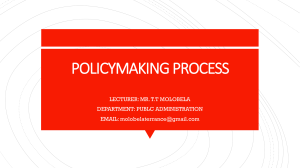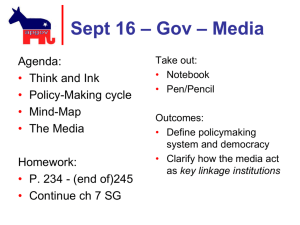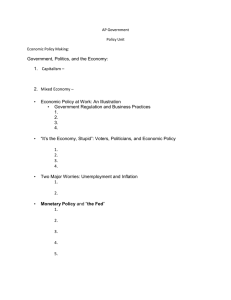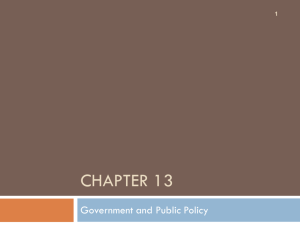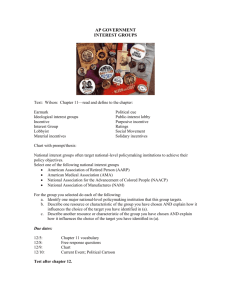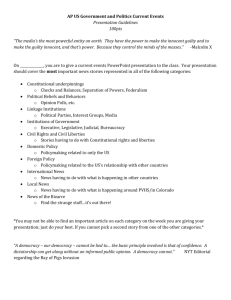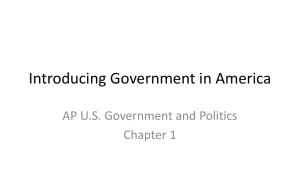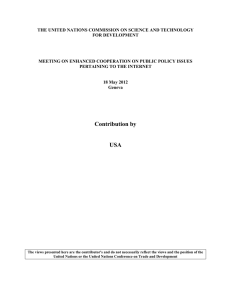PowerPoint file - Purdue University
advertisement
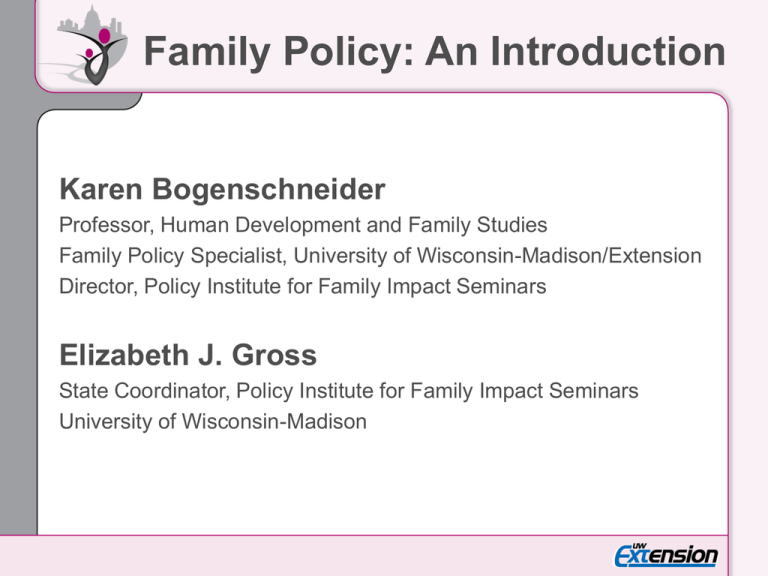
Family Policy: An Introduction Karen Bogenschneider Professor, Human Development and Family Studies Family Policy Specialist, University of Wisconsin-Madison/Extension Director, Policy Institute for Family Impact Seminars Elizabeth J. Gross State Coordinator, Policy Institute for Family Impact Seminars University of Wisconsin-Madison What is Family Policy? What is a Family Perspective in Policymaking? Definitions Explicit Policies: designed to achieve specific goals regarding the family Implicit Policies: not specifically or primarily intended to affect families, but which have indirect consequences on them Family Policy Is: A policy that derives from one of the following four functions of families: a) Family creation b) Economic support c) Childrearing d) Caregiving A Family Perspective in Policymaking Analyzes the consequences of any policy or program, regardless of whether it is explicitly aimed at families, for its impact on family well-being; examines: The ways families contribute to the problems, How families are affected by problems, and Whether families need to be involved in solutions. Why Might We Need a Family Perspective in Policymaking? Key Events in Family Policy History 1973 Hearings on the State of the American Family 1980 White House Conference on Families Family Policy Developments of the 1990s Philanthropic Commitments Federal Commitments State Commitments New Data Sources The Priorities of American Families The Importance of Families 91% of Americans reported that loving family relationships are extremely important to them. 61% of Americans reported that financial security is extremely important to them. 49% of Americans reported that job satisfaction is extremely important to them. Parents’ Attitudes Toward Putting Families on the Political Agenda 6% of Americans said that the government was doing a great deal to help them, Yet 47% said they felt government could be doing a great deal about their worries or concerns. Is U.S. Policymaking More Focused on Individuals or Families? The United States has no explicit national family policy nor comprehensive vision for families. (Elrod, 1999) Individualistic Nature of State Policymaking 1997 State Child Health Insurance Program (SCHIP) provides health care for children, but not their parents. Nannies are available for Social Security and Workman’s Compensation, but mothers are not unless employed outside of the home. Third-party payers cover individual treatment for mental health, but seldom cover marital or family therapy. The United States is one of only 6 countries that does not have paid family leave. Policymakers’ image of their client is disproportionately focused on individuals, with families relegated to the periphery of policy development, implementation, and evaluation. (Moen and Schorr, 1987) Are Family Approaches to Policymaking Effective? Effectiveness of Olds' Home Visiting Program 7.5 5 1.6 1.3 0.58 0.18 Mother's use of AFDC (in years) Mother's subsequent births 0.29 0.54 Mother's arrests Reports of child abuse or neglect Nurse-visited 0.2 0.45 Child's arrests Comparison Group The Oregon Social Learning Center’s Parent Education Program Children from participating families displayed less antisocial behavior, with improvements large enough to bring the target child (and sibling) into the range of normal functioning; effects lasted up to 4 1/2 years. (Patterson, 1986; Baum & Forehand, 1981) Do We Know How to Put Families on the Political Agenda? Two Methods for Putting Families on the Political Agenda Promoting a Broad-Based Family Policy Program Promoting a Family Perspective in Policymaking Criteria for Developing Family Policies Family policies are most apt to be enacted and sustained if they: Articulate the valuable service that families provide to society, Make room for the less privileged in universal programs that benefit all, Tap into a secure funding stream, and Secure backing from a voluntary association, preferably one with local, state, and national presence. (Skocpol, 1997) Promoting a Family Perspective in Policymaking Professionals need to: Monitor family trends and their implications for policy, Assess the impact of actual and proposed policies on families, Gather evidence on the effectiveness of family-focused policies and programs, and Foster the implementation of policies in ways that respect families and support their well-being. Criteria for Family Impact Analysis To promote family well-being, policies and programs should: Provide support so family members can fulfill their responsibility, Encourage parental and marital commitments and stability, Recognize the strength and persistence of family ties, Assure family empowerment and partnerships, Respect family diversity, and Include vulnerable families. Family Policy Advocates Campaign for an under-represented group or a particular policy alternative that may potentially enhance family well-being Examine options in light of their own value system, using a personal interpretation of the scientific evidence, with the aim of promoting a single policy option that they deem most desirable for families Family Policy Alternatives Educators Do not lobby for a single policy, but attempt to inform policy discourse by clarifying potential consequences of several policy alternatives Make an effort to educate by presenting research findings objectively without relaying personal preferences What policymakers need is not more information, but more objective and valid information from reliable, unbiased sources. (Strickland, 1996) No Magic Bullet The most desirable approach to including family issues in the policy arena may vary by the intended beneficiaries, the issue, the professional’s job context, and his or her personal communication style. For some professionals, advocacy may be the best approach for reaching policy goals, whereas for others alternatives education may be more appropriate. (Bogenschneider, 2002) http://www.familyimpactseminars.org Getting Involved Family Impact Seminars: An ongoing series of presentations, briefing reports, and follow-up activities which provide state policymakers with nonpartisan, solution-oriented information aimed at increasing the use of research in policy decisions and bringing a family focus to policymaking. For more information see: http://www.familyimpactseminars.org Putting Families First: A group of citizens building a community where life is an honored and celebrated priority. The democratic theory underlying this work is that the families can only be a seedbed for current and future citizens if they achieve a balance between internal bonds and external activities. For more information see: http://www.familylife1st.org Getting Involved The Midwest Welfare Peer Assistance Network (WELPAN) is a network of senior officials from Illinois, Indiana, Iowa, Michigan, Minnesota, Ohio, and Wisconsin which since 1996 has been meeting regularly to share ideas and compare notes on what it takes to make welfare reform work. For more information see: http://www.irp.wisc.edu/initiatives/outreach/welpan.htm Getting Involved Family Impact Analysis: Examines the past, present, or probable future consequences, both intended and unintended, that a policy, program, or service may have on family well-being. The Consortium of Family Organizations (COFO) has developed a set of six family impact principles and an accompanying checklist of questions for assessing the impact of any policy or program on families. Other checklists are available for gauging the impact of schools, communities, adolescent treatment centers, and state child and family service plans. For more information go to http://www.familyimpactseminars.org and click on Family Impact.

